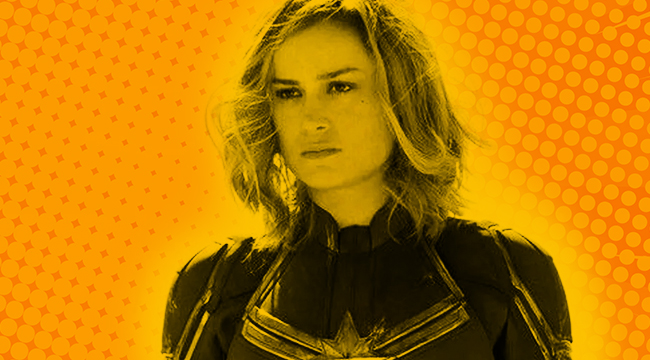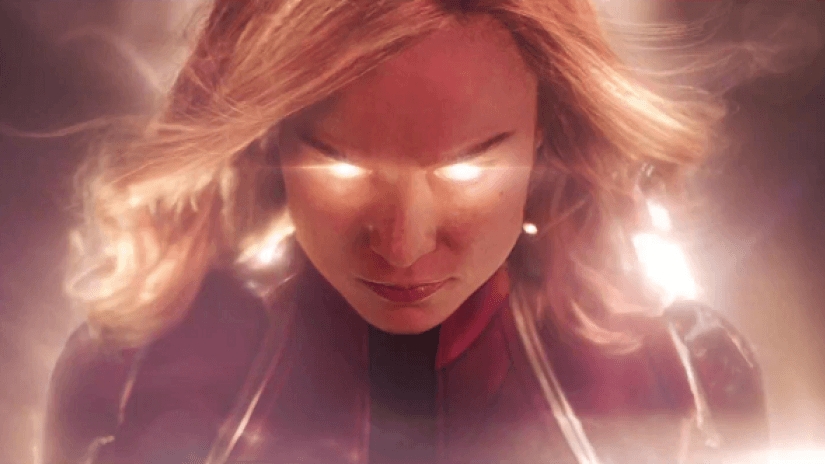
It’s a nice thing when the high points of a movie are so rich that they act as a sort of perception filter, allowing you to track minor annoyances without being able to really focus on them or have them dampen your enjoyment. That’s where I’m at with Captain Marvel. Because as Carol Danvers’ true heroic nature and abilities came to the fore at the culmination of the movie, I lost all ability to be bothered by bitty gripes. And upon reflection, I now feel like the film’s transformational and lengthy battle sequence may be more than the most thrilling part of a good movie. It may, in fact, be the most important action sequence in the history of the MCU. Disagree? Fair, but let me my make my case with these spoiler-filled thoughts that speak to the specific components that allow Captain Marvel to soar.
The Message
When Carol Danvers (Brie Larson) breaks the literal bounds that have kept her powers at bay and goes after the Kree warriors and Yon-Rogg (kicking off the aforementioned action sequence), we are seeing a moment that is clearly vital for the character’s evolution and the story. But it’s also something that stirs the audience due to the thematic proximity to real events going on in our culture.
Yes, a human, an aunt, a friend, a real hero — Danvers discovers that she’s all those things on Earth, but she’s also written to be an avatar for those who have been told to mollify others and tamp down both their power and their emotions. As such, Danvers’ eventual victory over Yon-Rogg (who had kept her like a pet project, limiting her access to those powers and training her to regard emotion as weakness) feels cathartic — especially in how it’s achieved (more on that later). It’s the same with the Skrulls and their third-act turn. Their displacement and search for safe harbor sparks thoughts about the immigration debate and the global refugee crises in the real world that are hard to ignore.
It’s an unmistakable leap forward for Marvel (and the MCU) that shows they’re willing to sidestep risk aversion and embrace socially relevant storytelling; this only works because the film’s writers and storytellers (Anna Boden, Ryan Fleck, Geneva Robertson-Dworet, Nicole Perlman, and Meg LeFauve) so deftly weave their message into Danvers’ hero journey and never forget to keep the characters, the story, and the action out front. This, in turn, allows the movie to forge a deeper connection and have greater cultural impact than it would have if Marvel and the writers had gone in another, less socially relevant direction. Which, to borrow a line from Captain Marvel, would have been akin to “fighting with one arm tied behind your back,” especially in 2019 when everyone expects everything to be political anyway.

Mike Ryan wrote a great essay on Superman: The Movie and the earnestness and uncomplicated goodness of Christopher Reeve’s Superman back in November for UPROXX, and there’s a moment where he talks about a scene in that movie where Superman hides a megawatt smile after a bit of do-goodery. It’s a great scene that, according to Ryan, signals how much Superman enjoys being good. I thought about that movie — specifically that scene and the one when Superman first takes flight — while watching Captain Marvel and the scene where Carol Danvers take her first real flight and lets out a whoop of joy. It’s the same thing she does in space when Kree ships run into her and explode with little effect. These are blink-and-you-miss them moments (I went to see the movie a second time, in part, because I wanted to make sure I heard right), but they deserve to be iconic because, more than any other scene in Captain Marvel, these illustrate that Carol Danvers is falling in love with her powers and that she, like that earlier version of Superman, is joyous and uncomplicated in her love of her sprawling capabilities and her ability to save the day.
The Scale
I’m awed by the ability of directors Anna Boden and Ryan Fleck to weave in and out of different settings and styles during what is a lengthy and varied action sequence. Things move from a close-quarters rumble in a ship to an outer space battle and then an earth-bound dogfight with ease. This all before a western inspired shootout pits Danvers and Yon-Rogg against each other for a moment that seems like a hat tip to Indiana Jones as Danvers decides she’s done with Yon-Rogg’s bullshit and simply shoots him, drawing applause in the showing I was at over the weekend.
The CG is glorious, never taking you out of the action or making you strain your imagination to go along with the story. And Pinar Toprak’s score aims to be iconic, with big horns that evoke the masters (like John Williams and that Superman: The Movie score) and the occasional quirky touch (like what sounds like a ’70s cop show effect at points). Additionally, while the selection is much maligned, the use of No Doubt’s “I’m Just A Girl” feels like a perfect change of pace following Danvers’ self-powered liberation, adding the right kind of poppy energy and relevant messaging to the mix.
The Power
On top of the messaging that pulls us in closer, the exuberance of a powered up Carol Danvers, and the scale that fully and truly bridges the cosmic and the earthbound aspects of the MCU, there is this: the action sequence at the end of Captain Marvel is the most important one in MCU history because of what it means for the future of the MCU. Or, rather, because of the sheer power on display.
Credit where it’s due, I didn’t see the big picture clearly until a conversation with SyFy Wire writer Matthew Jackson, who made a very important point: Captain Marvel had to be the most powerful force we’ve ever seen in the MCU because of how she’s been set up as an incoming savior in Avengers: Endgame. And it’s so true. The Avengers threw everything they had at Thanos in Infinity War and they lost. Barely, but they did lose. From the ashes of that defeat (what an unfortunate pun!) they need to come up with a new weapon, and Captain Marvel is likely the extent of it. And following that action sequence, is there any doubt that she’s the kind of force that can somehow defeat Thanos?
At some point down the line, Marvel may have a problem building a story around a character this invulnerable and God-like in her powers, but for right now, it’s exactly what the MCU needs and (probably) exactly what we’re going to get in Endgame. The only question is, can that film out-epic this one in the way that it utilizes Captain Marvel?
